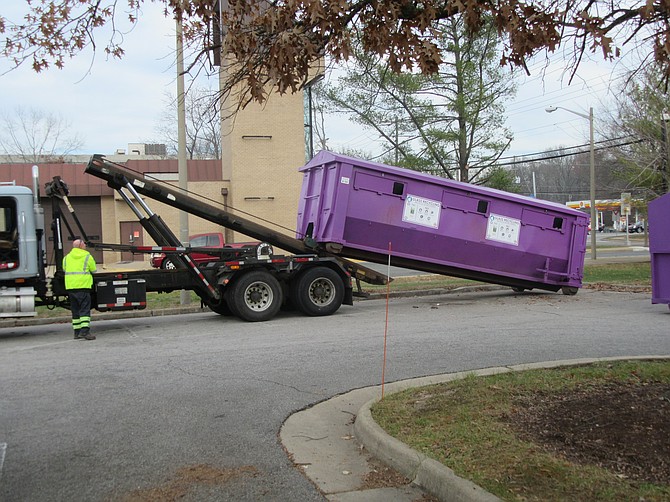That wine bottle you toss into Fairfax County’s purple recycling bin will likely get a new life and maybe several, thanks to the county’s glass recycling system. As Fairfax County Board Chairman Jeff McKay puts it, “Your next bottle of juice could be Fairfax County vintage glass!”
The county has 18 purple collection bins in every magisterial district, where since 2019, people have shoved glass bottles and jars through the bins’ windows day and night for recycling at the I-95 landfill complex. Alexandria and Loudoun County also take glass there. Fairfax County processed 7,240 tons of glass in 2021.
Before installing the purple bins, which county officials dub the “Purple Can Club,” Fairfax County collected most glass containers in what officials call a “single stream system” from curbside, individual blue bins. But most glass went to landfills, because glass in the waste stream could create problems, including damaging equipment and contaminating other recyclables, says McKay. Some jars and bottles went to a materials recovery facility where they were separated from other materials, ground up and used as landfill cover.
Today, glass containers deposited in purple bins take one of two paths. On the first path, haulers take the bottles in the purple bins to the I-95 landfill, dump them into a bunker and tractor trailer trucks from a Pennsylvania company called CAP Glass take them to their glass beneficiation plant to remove labels, separate them by color, remove plastics and metals and break them down into small pieces called “cullets.” CAP Glass sells the cullets to a glass manufacturing company, Owens-Illinois. Furnaces at Owens-Illinois’s two Virginia plants in Danville and Toano then melt the glass and the company makes new bottles. “Glass bottles and jars are 100 percent recyclable and can be recycled endlessly without any loss in purity or quality,” reports the CAP Glass website.
The other track is a “trip” through “Big Blue,” an Andela Products glass-crushing machine that pulverizes glass, pulls out any metals with magnets and spews out sand-like glass and glass pea “gravel.” Big Blue is the only glass crusher in Northern Virginia, say county officials. The glass “sand” is used as construction material, for example, as bedding material under pipes and fill material around pipes instead of the traditional crushed stone. “The glass aggregates processed by Big Blue are safe enough to walk on barefoot,” says Eric Forbes, Deputy Director of solid waste management.
Glass put in regular trash cans is burned at the Lorton Covanta Waste-to-Energy Plant with all the other non-recyclables.
“The Purple Can Club is a system to collect glass separately and allows us to truly recycle glass, keeping it out of landfills, where it was lost forever,” says Forbes. “We recycled 100 percent of the glass collected in the Purple Can Club, which is 98 percent pure glass thanks to our residents who participate in the program.”
“There are remarkable environmental benefits including reducing the volume in our landfills and lowering carbon dioxide and other greenhouse gases,” explains McKay. “There are also economic benefits as the County has to purchase fewer construction materials when it uses recycled glass. Glass-to-glass recycling even supports hundreds of jobs in the state. This is a true win for everyone and I hope all residents of Fairfax County and the region continue to support and participate in the Purple Can Club.”
Tom Blackburn of McLean puts glass containers in the purple bins because, he says, “Recycling is good for the environment. It cuts down on waste in landfills and it reduces the amount of raw material needed to manufacture new bottles.”
“Recycled glass can be substituted for up to 95 percent of raw materials,” maintains the Glass Packaging Institute. Recycled container glass uses include tile, filtration, sandblasting, concrete pavement and parking lots, says GPI.
Ann Allman, a Mount Vernon-Collingwood resident, offers, “I take my bottles to the purple bin because they’ll be recycled into something useful and to keep them out of landfills.”
Reston resident Joanne Bauer likes to recycle. “Initially, I worried that taking glass to the recycling bins and putting items in one at a time would be onerous. That turned out not to be true. Now it's just another task on the chore list and one I am happy to do for the environment," she says.
Some may even find it fun, suggests McKay. “We regularly encourage residents to join the ‘Purple Can Club’ and bring their bottles, jars and other household glass for easy disposal. It’s actually kind of fun, sending the bottles through and hearing a very satisfying crash and break at the bottom.”
Some bins fill up twice a week. Unscientific observations suggest that wine bottles top the list of glass container types left in the bins, says Forbes. “If you look at the piles of bottles at loading sites, it looks like there are a lot of parties going on,” he joked. “Glass recycling has been well received because people care about the environment. People want to do good.”
* Rinse out glass containers to remove any food or beverage residue.
* Check all the purple bins’ windows. The bin at one window may make the bin appear to be full when it is not.
* Do not put dishes, windows or other glass materials in the purple bins.
* Do not leave things behind like boxes, bags or other trash. That may be illegal dumping.
* If you observe broken glass at the bins, contact trashmail@fairfaxcounty.gov or 703-324-5230 to request a cleanup.
* To determine how best to dispose of items, visit the county’s waste wizard at https://www.fairfaxcounty.gov/publicworks/recycling-trash/residential-materials.
More Information: Fairfax County Glass Management, https://www.fairfaxcounty.gov/publicworks/recycling-trash/glass
The glass container recycling loop, https://www.gpi.org/glass-recycling-facts
